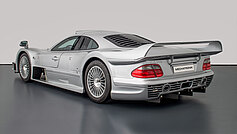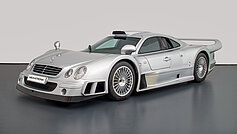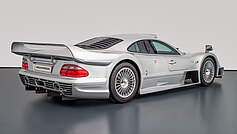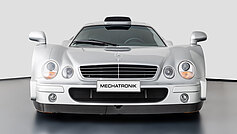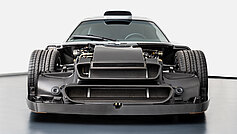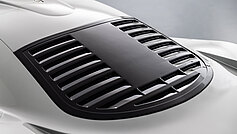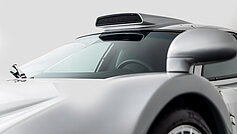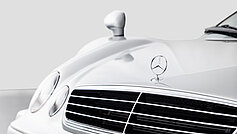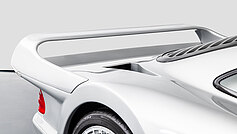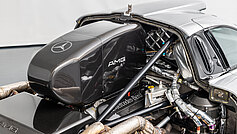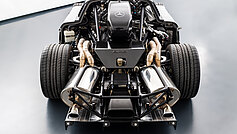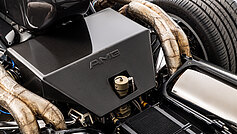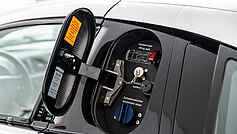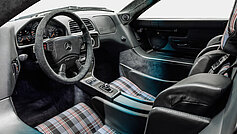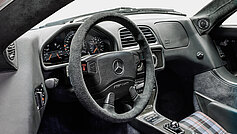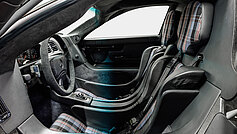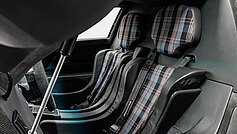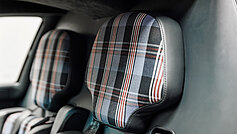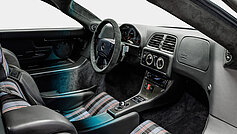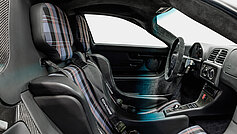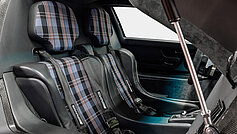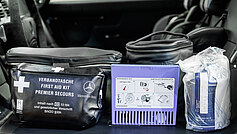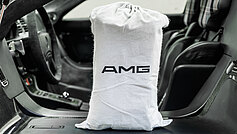Mercedes-Benz CLK GTR AMG
- One of only 20 CLK GTR Coupés built
- Delivery miles
- New car condition
- German delivery incl. COC
- Recent major customer service carried out by Mechatronik
- One of the rarest and most sought-after cars on the collector's market
- Homologation vehicle for the GT1 class
- Incl. original, service booklet and complete luggage set
| Year: | 1999 |
|---|---|
| Paintwork: | Silver 744 |
| Interior: | Blue checked fabric |
| Gearing Type: | Manual |
| Mileage: | Less than 100 KM |
|---|---|
| Power: | 612 HP |
| Fuel*: | Petrol |
| Price: | POR |
* Fuel consumption: 21.0 liters according to DIN 70030 standard, determined at 3/4 of the maximum speed, maximum 110 km/h, with an additional 10% surcharge.
Get in touch with your contact person for the Mercedes-Benz CLK GTR AMG now.
The Mercedes-Benz CLK GTR AMG
AMG Motorenbau und Entwicklungsgesellschaft was founded by former Mercedes engineers Hans-Werner Aufrecht and Erhard Melcher in the late 1960s. The company’s acronym was derived from Mr. Aufrecht and Mr. Melcher’s names, as well as the town of Grossaspach, near Stuttgart, where they were headquartered. After earning considerable respect tuning and racing Mercedes’ durable engines, most notably in the European Touring Car Championship, AMG became an official corporate partner. Heretofore, the relationship between the two had been rather informal, with AMG supplying aftermarket upgrades for more discerning, performance-oriented drivers. For the 1988 DTM season, however, the new Mercedes-Benz AMG team unveiled the sensational W201 touring race cars. The importance of AMG to Mercedes consequently increased, resulting in the acquisition of the tuning shop and the production of a limited number of AMG 190 E 3.2 road cars. At $90,000, the diminutive sedans carried an S-Class price tag and were capable of Autobahn-worthy speeds in excess of 250 km/h. This project evolved into the highly successful C-Class DTM cars that earned an impressive 84 wins in the 1990s. Such was the fabled start of AMG’s entrance into production sports car manufacturing.
By the mid- to late-1990s, however, there was ever-growing interest from Mercedes-Benz and Porsche to return to an ultra-exclusive form of racing, featuring homologated race cars in the tradition of the great Gran Turismo racers of yesteryear. The result was the FIA GT Championship, which commenced in 1997 to great fanfare and eager enthusiasm. Mercedes-Benz AMG would have to enter the top-level GT1 class and compete head-on with the astounding Porsche 911 GT1 and BMW-powered McLaren F1. In this sense, the upper echelon of FIA GT racing was essentially a battle between Germany’s top three automotive competitors. In order to participate in FIA GT, however, 25 homologated road cars had to be produced by each manufacturer. Not surprisingly, these limited-production cars were instantly collectible and highly sought after. The task was a monumental one; AMG had only four months to design, build, and test a viable and competitive race car and its road-going brother, with the intent of winning and doing so repeatedly. As there is no replacement for simple pencil and paper, the original designs were crafted as such and then perfected through the use of Computer Aided Design (CAD) before being translated into 1:5 scale three-dimensional clay models. Early in 1997, the proposed engine for the CLK GTR, a 6.9-liter V-12, was already undergoing rigorous testing from AMG’s expert engineers. By March of the same year, the other two components of AMG’s three-pronged racing campaign were in full swing: the American CART series kicked off in Homestead, Florida, and the new McLaren-Mercedes MP412 made its debut at the Formula 1 Grand Prix of Melbourne, Australia, where its victory marked the first win of a Silver Arrow since 1955. AMG, however, saved the best for last, as its mechanics worked round the clock on their most impressive product to date. Finally, only 128 days after the first sketches were conceived on paper, the very first CLK GTR took to the track in Spain.
Mercedes veteran Bern Schneider, along with AMG’s young gun, Alexander Wurz, tested the car with extremely successful results. Norbert Haug immediately called Hans-Werner Aufrecht from the pits at the Brazilian Grand Prix to see how testing was proceeding in Spain. Mr. Aufrecht, grinning, understated the car’s performance and said, “Er fährt . . . sieht gut aus” (“It runs . . . and looks good.”). Needless to say, the project was green-lighted by Mercedes’ board of directors. The CLK GTR did more than just run well. After only four months, AMG had produced two race-ready CLKs and one homologated road version, with 300 prospective buyers eagerly waiting in line. This first CLK GTR for the streets was presented to FIA Head of Constructors Gabriel Katringer on Monday, 1 April 1997, only six days before its race-ready brethren would make their debut at Germany’s home track, the Hockenheimring. Bernd Schneider not only picked up fastest lap honors, but also pole position in the CLK GTR’s maiden voyage. After a slightly staggered start to the season, the new AMG supercars reigned victorious at the A-1 Ring, Suzuka, Donington, Sebring, and Laguna Seca, taking the team championship back home to Affalterbach, while Schneider secured the Drivers’ Championship. For 1998, however, the CLK GTR saw rather limited use, as the 630-hp behemoth was being phased out by its descendent, the CLK LM, which was conceived with the 24 Hours of Le Mans in mind. Race regulations and conditions at Le Mans required that Mercedes’ entry receive certain upgrades in preparation for the world’s most famous endurance race. Unfortunately, the race-proven M120 V-12 was replaced by another naturally aspirated engine, the M119 V-8. Surprisingly, the V-8 produced equal amounts of horsepower and was believed to be better suited for long-distance racing. Additional aerodynamic modifications were made in the way of a lowered roofline and nose and redesigned air intakes. Ironically, the two CLK LMs retired early in the race due to engine failure. AMG returned to the FIA GT series unfazed, however, scoring six 1-2 finishes and securing the team championship, as well as the Drivers’ Championship for Ricardo Zonta and seasoned Mercedes racing driver Klaus Ludwig. In 1999, the FIA GT1 class was cancelled due to lack of interest from Mercedes’ competitors. As a result, Mercedes set about designing and building its CLR, a car that owed much of its design to the CLK GTR but was unrestricted by homologation requirements.
FIA HOMOLOGATION
McLaren’s entrance into the FIA GT1 class required that its already outstanding McLaren F1 road car be outfitted in racing trim. By contrast, the AMG solution to homologation was quite the opposite. Instead of building a race car from an existing sports car, AMG set about creating an all-new GT1 contender whose homologated variants were essentially nothing more than road-going race cars. As per FIA regulations, Mercedes ensured construction of 25 of these legendary machines, typically painted the historical German racing color: silver. AMG produced every car in Affalterbach, Germany, with minimal additional creature comforts, ensuring that each owner was delivered the next best thing to the race-proven CLK GTRs. Up front, next to the inboard suspension and radiator system, rested an air conditioning unit, while an anti-lock braking system was added for additional safety. The obvious lack of trunk space was slightly alleviated with two small storage compartments under each upward swinging door, while interior comfort was improved with leather appointments. Although no major aerodynamic changes were made, the car’s rear wing was sculpted to fit the body more smoothly, and the front air dam was also redesigned. Unlike the McLaren F1, the CLK GTR behaved like a bona fide race car on the street. Gear changes were lightning-quick, thanks to a paddle-operated six-speed sequential manual gearbox lifted directly from the GT1 cars. The mid-mounted 6.9-liter V-12 rested directly behind the driver, producing an utterly raw and menacing exhaust note. With the exception of four round headlamps and distinctive taillights, the CLK GTR shared little with its concurrently introduced passenger car, the Mercedes-Benz CLK.
CLK GTR No. 5
The CLK GTR offered here is number 5 of officially only 25 vehicles built, 20 of which were delivered as coupés and 5 as roadsters. However, 7 roadsters actually existed, including the prototype. According to the original service booklet, the delivery inspection was carried out on 29 April 1999 by the AMG CLK GTR Service Team in Ludwigsburg. The car was then delivered to its first owner, a German collector, who only registered the car for the first time more than a year after delivery, on 29 September 2000. Number five remained in Germany for the following years without changing hands. In spring 2007, however, the owner decided to offer the car for sale at auction. The choice fell on the Bonhams auction in Monaco, where the car was offered for sale on 21 May 2007. The estimate at the time was 700,000 - 800,000 euros. To the surprise of the consignor, however, no buyer was found for the car at this price and so it was returned to Germany. In summer 2012, according to the service booklet, the car was presented to Daimler AG in Pfaffehofen, Germany, for servicing. Particular attention was paid to the fuel system and, in addition to a new fuel tank, new filters and pumps were also installed. The mileage of the vehicle on 26.06.2012 was only 55 kilometres. Approximately one year later, CLK GTR No. 5 changed hands for the first time, who in turn sold the car to the current owner in 2017. The latter also recognised the uniqueness of the fact that this car still has its delivery kilometres and therefore decided not to drive the CLK. In terms of time, he attached great importance to the technical functionality of CLK GTR No. 5, which is why the car has recently undergone a major service at Mechatronik. Visually and technically, this vehicle is in absolutely new condition and represents an enrichment for any collection with the highest standards. The condition is rounded off by the original COC, service booklet and the complete bag set belonging to this car.
Our sales staff will be happy to answer any detailed questions you may have at any time. Please note that vehicle viewings are only possible by prior appointment.


